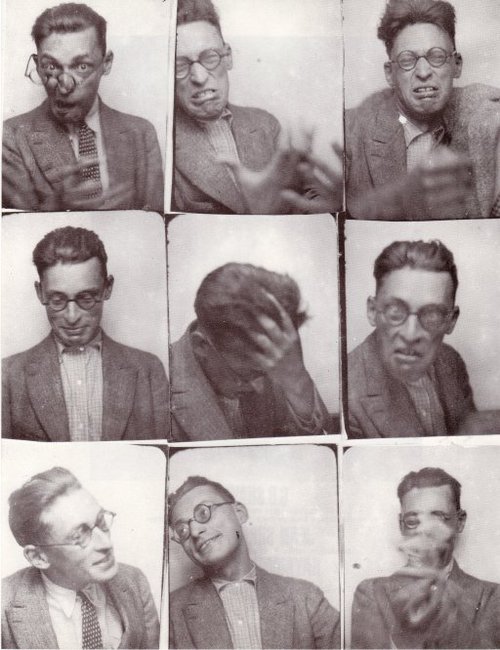
First published in French in 1947, Raymond Queneau’s Exercises in Style has appeared in over thirty languages — including Italian, thanks to Umberto Eco; Serbian, thanks to Danilo Kiš; and Esperanto, thanks to one István Ertl — and inspired a wide variety of tributes, from cartoon adaptation to theatrical performance to at least one set of erotic retellings. It’s easy to see why: Exercises in Style is an irresistibly simple and frequently hilarious demonstration of the potential of language, in which Queneau relates the same anecdote about a disagreement on a city bus in 99 different rhetorical registers — conversational, poetic, technical, comic, mathematical, genre-literary. The incident in question is nothing to write home about, which was surely Queneau’s point: the repetition and mundaneness of the non-story allows him to show just how much room for choice and mannerism — for style, high or low — is inherent in everything we commit to writing.
For the book’s 65th anniversary, New Directions is reissuing Barbara Wright’s 1958 English translation along with 25 previously untranslated exercises and a handful of new ones by contemporary Queneau acolytes (for aren’t we all acolytes?) including Harry Mathews, Amelia Gray, Jonathan Lethem, and Enrique Vila-Matas. The new edition hits shelves on January 31st. Below you will find a preview of the latter two categories: “Epistolary,” one of the styles left out of Queneau’s original 99, and “Instructions,” a brand new contribution from Jesse Ball.
INSTRUCTIONS
by Jesse Ball
Wake up early. Stretch your neck with a neck stretching device. Do so until it is long and supple. Tear a button off your overcoat—one of the lower ones. Make sure to bring your hat. It ought to be tall and tied with a felt cord. Under no circumstances show up with a ribbon around your hat.
Leave your house. Go to the corner. Get on the S bus. It doesn’t matter much why. Get on, and make sure it’s full. If it isn’t full, wait until another S bus comes—one that’s full. Get on that one.
Raise up all the indignation you can muster. Hold it steady. Hold it. When someone jostles you, even if no one jostles you, when someone seems to jostle you, make a stink. Don’t let that sort of thing pass, not even for a minute. And if it happens again…
When a seat opens, and I’ll say, ride that bus until a seat opens, you get in it. Get in the seat and sit down. I don’t care if a dying pregnant woman needs to sit down. You sit down. Such a woman—she’ll die anyway, along with everyone on the bus, and everyone you’re ever going to meet, etc., etc. Sit down.
Now here’s the tricky part. Find your way to that nice spot, the one in front of the Gare St. Lazare where the demented tailor, the one who imitates a dandy and sits around smoking cheroots, some people call him “Chaffy,” the spot where he spends his time. Walk back and forth near him until he notices your button problem. Try to time it so that you can be observed, so that right when he tells you about your missing button, all kinds of people can listen in.
After that, for all I care, you can go to hell. Collect your money later at the usual spot.
EPISTOLARY
(translated by Chris Clarke)
Dearest Totor,
Today my hand goes to the quill instead of to the plough, a way of telling you that I am writing you a letter that will share with you my most recent and joyous news. Can you imagine it, I went to see Aunt Hortense, and seeing as she lives over that way, I took the S bus that goes over that way. I remained on the platform so I could see the rather beautiful scenery parade past my eyes, round with wonder. But I’m not finished my story. And so I beg you not to throw my letter straight into the wastepaper basket and to listen to the rest. Well, actually, listen is just a figure of speech, or a figure of writing, seeing as it is a matter of reading.
Now where was I with my journey? Ah yes. I take up the thread of my tale in telling you (writing to you) that the bus came to a stop at a stop (that’s the rule) and a bizarre character hurriedly got on, one whom the word on the street had told me (orally) was a cool cat, that’s to say that he had a hat on his head with a plaited string around it, and what’s more, a long neck, and a look about him, oh my what a look! So as to not drag things out too long, I’ll tell you right now that this cool cat (because this was definitely a cool cat), treading upon the feet of one of my fellow standing passengers, went rushing off to sit down on a seat that had opened up.
That sickened me.
Now, on my way back from seeing Aunt Hortense (who is as fit as a fiddle, by the way), the bus that I rode passed before the Gare Saint-Lazare, allowing me to see with my own dumbfounded eyes the very same cool cat in the company of another lad of his sort, who was giving him advice on the placement of one of the buttons of his overcoat. That is all I have to tell you for the moment. I hope you have enjoyed hearing from me, and, as you can see, there are certainly things to see in such a big city as Paris. In hopes of seeing you in the not-too-distant future, I remain faithfully yours, my dearest Totor.




